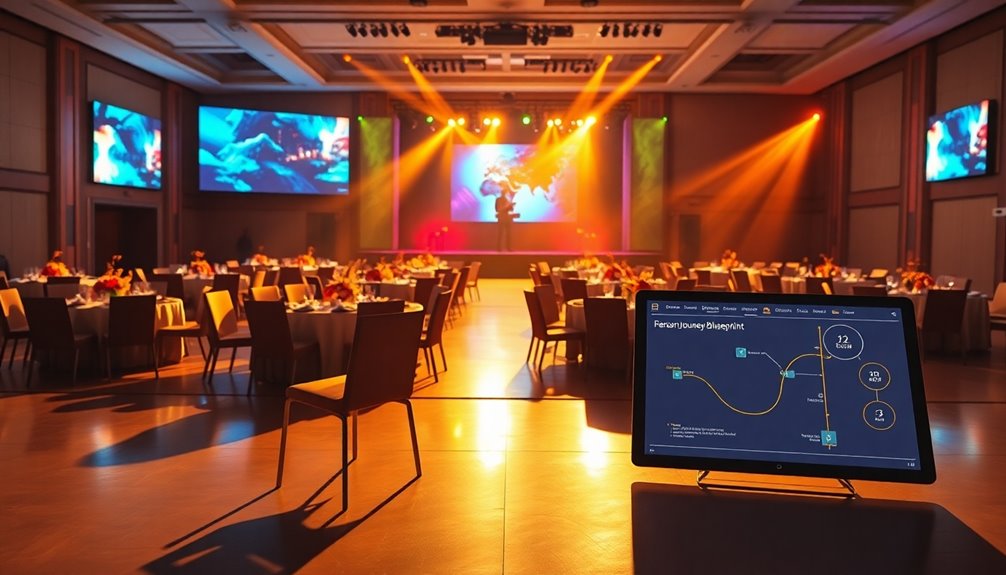When no one's showing up to your events, it's time to pivot fast. Start by understanding your audience's pain points through surveys and social listening. Personalize your communication to address their needs and offer tailored experiences. Create a sense of urgency with limited-time offers and showcase FOMO to pull them in. Don't forget to facilitate networking through engaging activities like speed networking and gamification. Lastly, highlight unique selling points, such as industry-leading speakers, to prove your event's relevance. Stick around to uncover even more strategies that can boost your attendance rates!
Key Takeaways
- Conduct urgent market research to identify immediate audience challenges and adapt your event accordingly.
- Leverage social media and surveys to gather real-time feedback and tailor content to current interests.
- Use personalized communication and targeted marketing to engage specific audience segments effectively.
- Foster community by creating networking opportunities and interactive activities that enhance attendee engagement.
- Implement strategic promotion techniques, such as teasing unique experiences and creating urgency with limited-time offers.
Address Audience's Pain Points

When you understand and address your audience's pain points, you can create a more compelling event experience that resonates with them.
Start by conducting market research to pinpoint the challenges they face. Gather feedback from past attendees and prospects through calls, webinars, and events. Engage in social listening to catch common discussions on social media and forums. Surveys can also provide valuable insights into their needs. Additionally, identifying challenges helps tailor your content in a way that directly speaks to the audience's interests and needs. For example, understanding the demand for healthier dessert alternatives can help you incorporate relevant themes into your event that align with current consumer trends.
Once you've identified these pain points, tailor your content accordingly. Segment your audience to personalize messaging, utilize dynamic content, and maintain engagement through follow-ups.
Create a Personalized Journey

Creating a personalized journey for your event attendees significantly enhances their overall experience and satisfaction. Start by sending tailored messages that address them by name and spotlight sessions aligned with their interests. Use AI to suggest activities based on past preferences, making engagement more meaningful. Segment your communication based on demographics and behaviors, ensuring everyone receives relevant content. Additionally, craft marketing messages that resonate with specific audience personas, highlighting unique experiences they'll love. Offering exclusive discounts for particular groups can further boost attendance. Successful personalization leads to increased engagement and attendance, illustrating the effectiveness of these strategies. Furthermore, utilizing strong communication skills can help you effectively convey the value of the event to potential attendees. Don't forget to gather feedback through surveys and social media analytics, allowing you to refine strategies continuously. By customizing the attendee experience, you create a memorable event that draws people in and keeps them engaged.
Leverage Contact Database

Leveraging a contact database is essential for enhancing event attendance and engagement. Start by collecting data at registration, including names, emails, and interests. Expand payment options to track traffic sources, helping you optimize your marketing channels. Utilizing data analytics can provide deeper insights into attendee preferences and behaviors, allowing for more focused outreach. Utilize event platforms for on-site surveys and real-time feedback, allowing you to address attendee concerns promptly. Pay attention to social media by monitoring hashtags and engaging with attendees' posts, using their feedback to improve future events. Finally, integrate your contact database with CRM systems to associate contacts with their attendance records. This way, you can generate insightful reports on participation and refine your strategies for upcoming events. Additionally, pre-event data collection allows you to better understand your target audience and tailor your marketing efforts accordingly. A well-utilized database transforms event planning and boosts attendance effectively.
Facilitate Networking Opportunities

Facilitating networking opportunities is crucial for enhancing attendee engagement and satisfaction during your event. Start by creating a gated online community for registered attendees, allowing them to connect before the event. Integrate this community into your event app for easy access and early engagement. Develop a well-thought-out networking strategy, utilizing platforms and matchmaking tools to facilitate meaningful connections. Organize breakout sessions and allocate time for intimate face-to-face interactions with key speakers and exhibitors. Establish networking-conducive spaces like lounges and coffee stands, and kick off with a pre-event gathering for newcomers. Lastly, explore creative activities like speed networking and human bingo to encourage interaction. Implementing such strategies can lead to improved attendee satisfaction, as genuine interest in others fosters meaningful networking.
Gamify the Event Experience

To enhance the overall experience of your event, gamifying it can be a game changer. Start by setting clear goals, such as boosting engagement or driving sponsor interactions. Tailor the activities to your audience's interests, ensuring they're easy and enjoyable to participate in. Incorporate effective gamification tools like leaderboards, points, and achievement badges to motivate attendees. Implement engaging activities, like a hashtag challenge or scavenger hunt, to create excitement and interaction. Additionally, successful gamification aligns with audience interests and event objectives to foster memorable interactions. For example, incorporating themed activities that reflect participant interests can further enhance engagement. Don't forget to monitor progress and adjust strategies as needed.
Plan Seasonal Events Strategically

When you plan seasonal events strategically, you can maximize attendance and engagement by aligning your offerings with peak demand periods.
Start by diversifying your services to include seasonal specialties, like winter weddings or summer festivals, which draw larger crowds. Create year-round engagement opportunities, keeping clients interested and active in your services. Additionally, implementing client relationship management strategies can further enhance your connection with attendees and encourage repeat participation. Consider how employer-sponsored retirement accounts can help you plan financially for these events.
Don't hesitate to implement loyalty programs or personalized services that encourage repeat business. Additionally, consider crafting off-season offers with discounts or bundled packages that attract clients during slower months.
Conduct market research to uncover emerging trends, allowing you to stay ahead of the competition. By anticipating needs and planning ahead, you'll ensure your events resonate with your audience when it matters most.
Set SMART Goals

Setting SMART goals is crucial for boosting event attendance, as it provides a clear framework for what you want to achieve. Start by defining specific objectives, like "Increase event attendance by 20% within the next 6 months." Make sure your goals are measurable; track attendance numbers and analyze data regularly. The SMART framework enhances focus and motivation in achieving goals, helping to clarify the path forward. Assess your resources to ensure your targets are achievable, considering any constraints you might face. Set realistic expectations based on your current attendance and align your goals with your overall business objectives. Finally, establish a time-bound plan with deadlines and regular check-ins every two months to monitor progress.
Prove Event Relevance

How can you ensure your event stands out in a crowded marketplace? Proving relevance is key. Start by showcasing data that highlights attendance numbers, engagement rates, and industry recognition.
Use testimonials and case studies to demonstrate past successes. Encourage user-generated content by creating a unique hashtag and sharing attendee experiences on social media. Incorporate audience engagement strategies to foster a more interactive environment that keeps your participants involved.
Partner with influencers to amplify your reach. Incorporate interactive content like webinars, polls, and live Q&A sessions to keep your audience engaged. Additionally, ensure you utilize social media to connect with your audience and promote your event effectively.
Personalize communication and offer customized agendas based on attendee preferences. Lastly, showcase social proof to build trust.
When potential attendees see real value, they'll be more likely to join your event.
Use FOMO Effectively

To maximize attendance at your event, tapping into the fear of missing out (FOMO) can be incredibly effective.
Start by highlighting unique experiences like industry-leading speakers and exclusive workshops to create a sense of scarcity. Use teasers and previews to build anticipation, and don't forget to leverage social proof—share testimonials from past attendees to boost credibility. Additionally, focusing on creating a sense of FOMO through a compelling narrative can significantly enhance the appeal of your event. Research shows that cultural beliefs often intertwine astrology with self-image and confidence, which could be an appealing aspect to incorporate into your event marketing.
Emphasize limited availability by promoting time-sensitive offers and displaying live ticket counts.
Create urgency with countdown timers and mention limited seating to encourage quick action. Engage potential attendees through interactive polls and encourage them to share their excitement on social media.
Frequently Asked Questions
How Can I Measure Event Success Beyond Attendance Numbers?
To measure event success beyond attendance numbers, focus on engagement metrics like session participation and interactive session involvement.
Utilize real-time data from event apps and track social media mentions.
Evaluate content impact through session ratings and speaker feedback.
Assess networking outcomes by monitoring connections made and meetings arranged.
Lastly, quantify ROI by tracking leads generated and partnerships formed.
These metrics give you a clearer picture of your event's overall success.
What Are Effective Ways to Promote Events on Social Media?
"All publicity is good publicity."
To promote your events effectively on social media, utilize engaging contests and giveaways to attract attention.
Leverage Instagram and Facebook stories to share behind-the-scenes content and live updates.
Create custom event pages for easy access to details, and consider paid ads to reach targeted audiences.
Engage with interactive content like Q&As and polls to foster community involvement, ensuring your event stays top of mind for potential attendees.
How Can I Create Engaging Content for My Event?
To create engaging content for your event, start by defining a central theme that aligns with your audience's interests.
Diversify your content formats—mix blogs, videos, and interactive polls to cater to different preferences.
Develop a content calendar to build anticipation and ensure timely releases.
Leverage automation tools to maintain a steady flow of posts and monitor engagement.
With these strategies, you'll keep your audience intrigued and eager to participate.
What Should I Include in Post-Event Follow-Ups?
In your post-event follow-ups, include clear objectives, such as gathering feedback and measuring ROI.
Start with an initial follow-up within 24 hours, then send regular updates and thank-you emails.
Utilize various communication channels like email and social media to engage attendees.
Craft effective emails with engaging subject lines, concise content, and a clear call to action.
Lastly, ensure your tone is professional, and proofread for any errors before sending.
How Do I Handle Negative Feedback From Attendees?
When handling negative feedback from attendees, start by acknowledging their concerns and apologizing sincerely, both publicly and privately if needed.
It's crucial to understand their perspective and determine whether it's constructive criticism or just a complaint.
Respond promptly and transparently, showing appreciation for their input.
Act quickly to implement necessary changes, and keep them updated on the actions taken.
This demonstrates you value their feedback and are committed to improving their experience.
Conclusion
To boost attendance at your events, focus on addressing pain points and creating personalized journeys. Leverage your contact database and facilitate networking opportunities, while gamifying the experience to engage your audience. Plan seasonal events strategically and set SMART goals to measure success. Prove the relevance of your events and use FOMO to ignite excitement. By implementing these strategies, you'll not only attract attendees but also create memorable experiences that keep them coming back for more.









